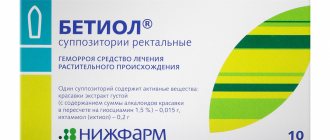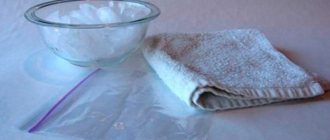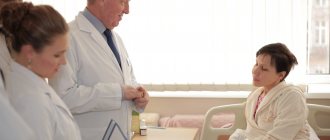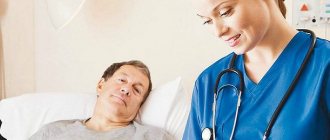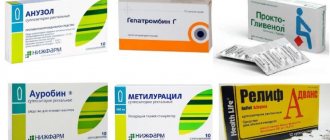Pathological expansion of hemorrhoidal veins and the formation of nodes in the anal canal are characteristic of hemorrhoids.
People facing this problem experience discomfort and are unable to lead a full life. The first symptoms of the disease often go unnoticed or are ignored. This leads to progression of the disease.
False embarrassment and fear that hemorrhoids cannot be treated without surgery are additional factors that prevent you from visiting a proctologist.
Stages of chronic hemorrhoids:
Stage 1 - discharge of scarlet blood from the anus without prolapse of hemorrhoids Stage 2 - prolapse of hemorrhoids with the preserved ability of their independent reduction Stage 3 - periodic prolapse of hemorrhoids with the possibility of manual reduction Stage 4 - constant prolapse of hemorrhoids along with the rectal mucosa intestines and the impossibility of their manual reduction.
Symptoms of external hemorrhoids
External hemorrhoids are accompanied by a number of specific symptoms. That is why, when making a diagnosis, an experienced doctor can immediately identify this disease. In the early stages there are no symptoms. Starting from the second stage, the patient is bothered by such signs as:
| Bloody discharge in stool | After each act of defecation, the patient notices that blood clots have appeared in the stool. Also, a symptom of hemorrhoids can be impurities of pus and mucus in the stool. In the early stages, bleeding is drip-like. In advanced cases, stream bleeding occurs, which bothers the patient every day after each bowel movement. The blood has a bright scarlet hue. As a rule, bloody discharge appears on the stool, and not inside it. This symptom indicates mechanical damage to the veins. |
| Painful sensations during defecation | When emptying the intestines, the patient experiences cramping pain. They are associated with stagnation of feces in the body, which turns to stone. When a person strains to defecate, anal fissures form, which lead to hemorrhoids. The pain intensifies when coughing, when walking, when sneezing. In some cases, pain occurs during a sedentary lifestyle or physical work. Each patient's pain pattern is different. In the third and fourth stages, the pain does not disappear even after taking painkillers. The patient is forced to consult a proctologist. |
| Sensation of an otherworldly object in the anus | When moving, the patient begins to feel the presence of an otherworldly body in the anus. This occurs with enlarged hemorrhoids. |
| Itching and burning in the anus | With hemorrhoids, common symptoms include burning and itching in the anus. The discomfort intensifies when walking. |
| Nodules around the anus | The anal area is constantly damaged, the functioning of the sphincter is disrupted, and therefore nodular neoplasms are formed. The size of the nodes is on average two centimeters. If left untreated, the veins become clogged with blood clots. |
| Hardening and discoloration of hemorrhoids | As the disease progresses, hemorrhoids become denser and increase in size. They acquire a dark blue hue, which indicates swelling and inflammation. |
| Tissue necrosis | This symptom is also a complication of hemorrhoids. Hemorrhoids change color and become purple or black. Such a change is extremely dangerous for human health and life. |
| Lack of appetite | With hemorrhoids, intestinal dysfunction is observed. The patient has no appetite. Associated symptoms include vomiting, belching and nausea after eating. If the above symptoms appear, you should change your diet and eliminate foods that cause fermentation. |
| General weakness of the body | With proctological diseases, the patient feels general weakness and lack of energy. Blood pressure and body temperature decrease. Fever and chills begin. |
| Diarrhea and constipation | Impaired functioning of the gastrointestinal tract negatively affects intra-abdominal pressure. The patient's abdomen becomes bloated, colic and flatulence appear, which disrupts the usual way of life and brings discomfort. With diarrhea, the mucous membrane of the anus is irritated, anal fissures form, and soft tissues are irritated. Constipation is also dangerous to your health. Lead to stagnation of feces in the human body. |
Also, a person who suffers from hemorrhoids may experience dizziness, tinnitus, and lack of coordination.
Treatment of hemorrhoids without surgery:
Treatment of hemorrhoids without surgery is most effective in the early (1-2) stages of hemorrhoids, in the acute period of the disease and in the presence of contraindications to surgical treatment.
Conservative (without surgery) treatment of hemorrhoids involves prescribing specific drug treatment regimens with drugs that help relieve inflammation and normalize blood flow in thrombosed hemorrhoidal veins. According to indications, our doctor will additionally prescribe physiotherapeutic methods for treating hemorrhoids in combination with local effects (ointments and suppositories). Great importance must be paid to following a diet to normalize stool, which will be discussed in detail in more detail about the operation .
Reasons for the development of hemorrhoids
There are many reasons that influence the development of proctological disease. Among them, it is worth paying attention to the fact that
- With increased physical activity, intra-abdominal pressure increases, cavernous veins are deformed and damaged, and the vessels become weak and thinned. The risk group includes construction workers, security guards and other people who work physically. Athletes and gymnasts are prone to developing hemorrhoids. Lifting weights also provokes the development of proctological diseases.
- With a passive lifestyle, hemorrhoids develop in most cases. Feces stagnate in the body, the vessels of the anus dilate. The work of the esophagus is disrupted and hampered, the patient constantly feels discomfort in the abdominal organs. The risk group includes office workers, drivers, and salespeople.
- People who are genetically prone to hemorrhoidal diseases have weakened internal organs from birth, the functioning of which is regularly disrupted. The vessels are thin, susceptible to inflammation. Venous blood overflows the veins, stagnates in the cavernous veins and leads to the formation of thrombosis.
- With soft tissue hyperplasia, hemorrhoids are diagnosed in most cases. We are talking about the dilation of blood vessels in the anal area. The veins become tortuous and damaged, and become injured. The blood stagnates, so intra-abdominal pressure increases. Collagen fibers weaken and form longitudinal muscles. The size of hemorrhoids increases.
- Constant disturbances in the functioning of the gastrointestinal tract have an extremely negative impact on the condition of the vessels in the anus. Bleeding begins and the mucous membrane becomes inflamed. The patient feels discomfort that does not disappear.
- If a person is diagnosed with a duodenal ulcer, chronic gastritis, duodenitis, proctitis, then hemorrhoids develop in parallel. The patient's condition deteriorates sharply.
- During pregnancy, the weight of the woman and the embryo constantly increases. There is strong pressure on the abdominal organs. Their functionality is impaired, anal fissures form, and the size of hemorrhoids increases. When pushing and laboring, the pregnant woman pushes hard, which affects the thinning of blood vessels and soft tissues.
- Infectious diseases and inflammatory processes provoke the development of proctological pathologies. The body as a whole weakens. An external lump of hemorrhoids appears.
- An unhealthy diet can cause hemorrhoids. Fatty and smoked foods, baked goods, sweets, salty and spicy foods have a negative impact on the condition of the intestines. The microflora is disrupted, the esophagus does not function as it should.
- Smoking and alcohol abuse negatively affect the condition of all internal organs, including the digestive tract. Inflammation of the walls of the rectum is observed.
Parkes hemorrhoidectomy:
Parkes hemorrhoidectomy is less traumatic for the patient, although more labor-intensive for the surgeon performing the operation. The operation involves removing the hemorrhoidal tissue while preserving the mucous membrane. Surgical treatment of hemorrhoids according to Parks, also performed under general anesthesia, requires hospitalization for at least one day, but is tolerated more easily by patients than the Milligan-Morgan operation. The postoperative period and the patient’s rehabilitation period with this type of operation are significantly reduced.
How to prepare for surgery
Preoperative examination includes an examination by a doctor and a number of laboratory and instrumental examinations, among which the following are mandatory:
- blood and urine tests (general);
- biochemical blood test;
- coagulogram;
- determination of blood group and Rh factor;
- blood test for antibodies to HIV and hepatitis viruses.
A few days before the planned date of surgery, the patient should adhere to a special diet with a minimum of foods that stimulate peristalsis. On the eve of the operation and 2-3 hours before it, you should do a cleansing enema. You should definitely tell your doctor if you are taking any medications; you should evaluate the possibility of taking them during and after surgery.
Advantages of minimally invasive methods for treating hemorrhoids:
When comparing minimally invasive methods for treating hemorrhoids (laser vaporization and disarterization according to HAL-RAR), one can note their significant advantages over traditional surgical methods of hemorrhoidectomy:
- high treatment efficiency (up to 98%)
- minimal damage to underlying tissues
- The operation lasts only about half an hour
- practically absent or mild pain syndrome
- quick rehabilitation period
Our clinic is equipped with modern equipment for accurate, quick diagnosis and effective treatment of hemorrhoids. All equipment is reliably imported.
proctologists with extensive experience will work with you Do you want to live a full life without pain? Come to our clinic!
Postoperative period
Rehabilitation after removal of hemorrhoids is the most important stage in the patient’s life. After any operation, efforts should be made to prevent complications and accelerate tissue healing. In the postoperative period, we prescribe a protective regime, a strict diet and certain medications.
The following rules must be observed:
- hunger on the first day after surgery (drinking liquids is allowed);
- a diet that excludes foods with a gas-forming effect - prohibited: black bread, legumes, milk, cabbage;
- It is forbidden to eat pickled foods, pickles, spices;
- alcohol is excluded;
- the diet is enriched with fermented milk products, it is recommended to consume a large volume of liquid - at least 1.5-2 liters per day;
- heavy physical labor is limited for at least 3 weeks after surgery;
- careful personal hygiene is required.
If coloproctological diseases occur, contact the Federal Scientific and Clinical Center of the Federal Medical and Biological Agency of Russia in Moscow - we will help solve any health problems.
Is it always necessary to treat acute thrombosis of the external hemorrhoid?
The choice of treatment method for this disease is one of the most controversial issues in general proctology. Like hemorrhoids, acute thrombosis does not turn into cancer, does not cause deadly complications, but can significantly affect the patient’s quality of life; the pain syndrome is often described as “unbearable”, with which it is “simply impossible to live.”
Our Clinic has adopted a patient-centered approach to choosing a treatment method for acute thrombosis of external hemorrhoids: the doctor, together with the patient, determine how severe the symptoms are, how much the patient’s quality of life suffers, taking into account his employment, and choose a treatment method.
Acute thrombosis of the external hemorrhoid can be treated promptly (perform surgery), conservatively (take pills and use topical ointments and/or suppositories) or not treat at all, but choose a wait-and-see approach. Research and practical experience show that surgical treatment allows you to get rid of the manifestations of the disease in a shorter time; conservative treatment also allows you to get rid of the manifestations of the disease, but over a much longer time. The absence of any treatment also ends with recovery, the timing of which differs only slightly from the timing of intensive conservative treatment. The determining factor in the choice of treatment method is the patient’s choice and his assessment of the severity of the pain syndrome, therefore, the patient’s opinion is crucial for the choice of tactics. If the patient assesses the pain as unbearable, or he urgently needs to return to work, fly to another city or country, it is more reasonable to choose surgical treatment in the scope of removing the hemorrhoidal node or evacuating the blood clot from the node. Surgical treatment usually leads to faster relief of unpleasant symptoms. If the pain syndrome allows the patient to live fully in this condition or the patient is not ready for surgical intervention, it is possible to carry out conservative treatment aimed at reducing the pain syndrome and accelerating the process of organizing and resolving the blood clot.
Physical activity
It is important to know that the period after hemorrhoid removal is the time when you need to be especially attentive to your well-being. Ask your doctor about when you can return to normal physical activity.
During the first months, in good health, light physical activity is recommended, which may include:
- walking. Walking does not involve significant stress; it is an accessible and safest exercise even after hemorrhoidectomy. Start with a leisurely short walk every day, then the pace and time can be increased. Walking will help prevent constipation and improve blood circulation;
- morning exercises. Every morning, do a set of simple exercises that your doctor recommends;
- gymnastics with an emphasis on the abdominal muscles;
- flexibility exercises such as yoga.
If you experience pain or discomfort during exercise, stop doing the activity and talk to your doctor.
Systemic drugs
Prescribed for the treatment of acute/chronic hemorrhoids during the initial manifestations, as well as to prevent exacerbations of chronic hemorrhoids. This is especially true in the chronic course of the disease or after surgery to excise nodes.
More often, a combined course of phlebotropic (affecting the tone of the veins) drugs is carried out. Their modern types are developed on the basis of flavonoids (substances of plant origin that can influence. They are distinguished by high pharmacological activity and affect various parts of the pathogenesis (development mechanism) of the disease. They also help improve blood microcirculation in the cavernous bodies, normalize the tone of the veins. All this can lead to eliminating inflammation, reducing swelling, normalizing lymph flow.
Are there ways to prevent relapses/recurrences of the disease?
Prevention of relapse of the disease is based on excluding possible causes of thrombosis. These include hard stools, constipation or diarrhea, “reading on the toilet,” insufficient or, conversely, excessive physical activity (weightlifting, fitness), and prolonged sedentary work. Unfortunately, there are no unambiguous methods for preventing the occurrence of acute thrombosis of the external hemorrhoid; we can only reduce the likelihood of its occurrence, but not completely eliminate it. However, it should be noted that with conservative treatment the likelihood of recurrence of the disease is higher than after operations.
What causes acute thrombosis of the external hemorrhoid?
The occurrence of thrombosis is often caused by overflow of the veins of the external hemorrhoidal plexus with blood, followed by a slowdown in blood flow in these vessels and the occurrence of blood clots. Thrombosis against the background of venous congestion most often develops after sudden or prolonged stress. Classic examples of such overexertion are heavy lifting, straining during constipation or diarrhea, and childbirth. Chronic stagnation of blood in the pelvic organs (which includes the anal canal) occurs with prolonged sitting, excess body weight, and insufficient physical activity.
How does acute thrombosis of the external hemorrhoid manifest?
Patients with acute thrombosis of the external hemorrhoid complain of a protrusion, “bump” (neoplasm) and/or pain of varying intensity in the anus. The size of the “bump” can range from several millimeters to several centimeters and is often accompanied by swelling of the surrounding tissues (up to the entire circumference of the anal canal). In some patients, the disease proceeds without pain, but most assess the pain as significant or unbearable.
To assess the degree of pain, a special visual analogue scale is used, in which you can independently determine the severity of pain. After all, this is the key point when choosing a treatment method. Surgical treatment will be most effective when the severity of pain is 7 or more points, while for pain up to 4 points, a conservative method of treatment can be considered optimal.
Rice. Visual analogue scale for pain assessment.
Pain usually worsens during bowel movements and/or sitting. The pain and swelling can be severe, even unbearable for several days. The intensity of pain depends on the size of the blood clot and its location in relation to the anal sphincter muscles. In general, manifestations of the disease can persist for several weeks, in exceptional cases longer. Sometimes spontaneous evacuation of a blood clot from a hemorrhoid occurs. This is preceded by necrosis (destruction) of the skin over the thrombus, and the thrombus seems to “fall out” of the node. Externally, this is accompanied by the sensation of a “bursting” ball and the release of a small amount of blood. Usually, after evacuation of the blood clot, the pain and discomfort in the anus gradually decrease. However, necrosis of the mucous membrane above the thrombus does not always end only with the evacuation of the thrombus; necrosis can continue to spread to the hemorrhoid itself and surrounding tissues, which is why this condition requires consultation with a specialist. After acute thrombosis subsides, the patient is most often left with so-called “skin fringes” - excess skin where the thrombosis was. They do not require medical treatment, but may cause cosmetic discomfort.
